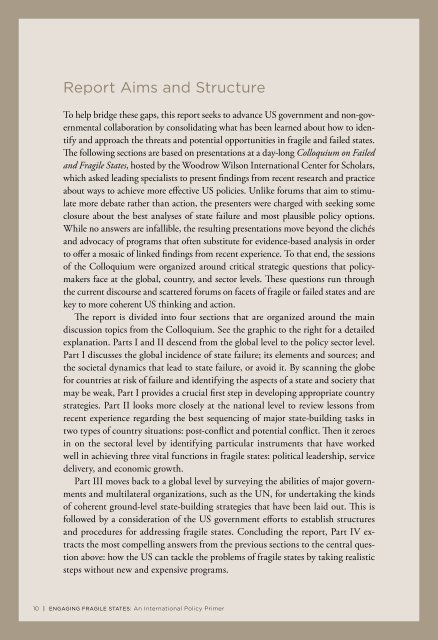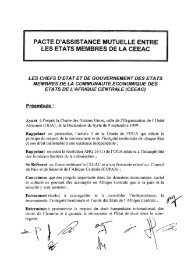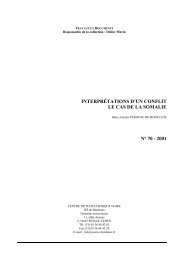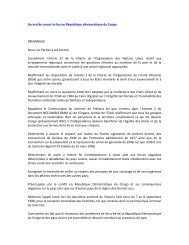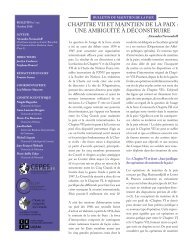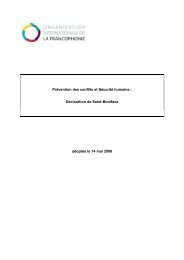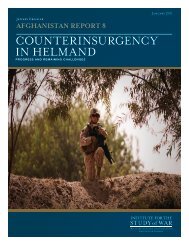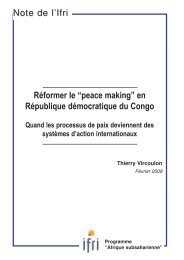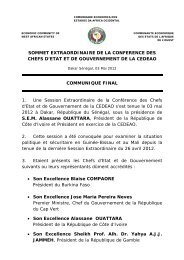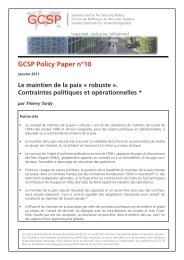engaging fragile states - Woodrow Wilson International Center for ...
engaging fragile states - Woodrow Wilson International Center for ...
engaging fragile states - Woodrow Wilson International Center for ...
You also want an ePaper? Increase the reach of your titles
YUMPU automatically turns print PDFs into web optimized ePapers that Google loves.
Report Aims and Structure<br />
To help bridge these gaps, this report seeks to advance US government and non-governmental<br />
collaboration by consolidating what has been learned about how to identify<br />
and approach the threats and potential opportunities in <strong>fragile</strong> and failed <strong>states</strong>.<br />
The following sections are based on presentations at a day-long Colloquium on Failed<br />
and Fragile States, hosted by the <strong>Woodrow</strong> <strong>Wilson</strong> <strong>International</strong> <strong>Center</strong> <strong>for</strong> Scholars,<br />
which asked leading specialists to present findings from recent research and practice<br />
about ways to achieve more effective US policies. Unlike <strong>for</strong>ums that aim to stimulate<br />
more debate rather than action, the presenters were charged with seeking some<br />
closure about the best analyses of state failure and most plausible policy options.<br />
While no answers are infallible, the resulting presentations move beyond the clichés<br />
and advocacy of programs that often substitute <strong>for</strong> evidence-based analysis in order<br />
to offer a mosaic of linked findings from recent experience. To that end, the sessions<br />
of the Colloquium were organized around critical strategic questions that policymakers<br />
face at the global, country, and sector levels. These questions run through<br />
the current discourse and scattered <strong>for</strong>ums on facets of <strong>fragile</strong> or failed <strong>states</strong> and are<br />
key to more coherent US thinking and action.<br />
The report is divided into four sections that are organized around the main<br />
discussion topics from the Colloquium. See the graphic to the right <strong>for</strong> a detailed<br />
explanation. Parts I and II descend from the global level to the policy sector level.<br />
Part I discusses the global incidence of state failure; its elements and sources; and<br />
the societal dynamics that lead to state failure, or avoid it. By scanning the globe<br />
<strong>for</strong> countries at risk of failure and identifying the aspects of a state and society that<br />
may be weak, Part I provides a crucial first step in developing appropriate country<br />
strategies. Part II looks more closely at the national level to review lessons from<br />
recent experience regarding the best sequencing of major state-building tasks in<br />
two types of country situations: post-conflict and potential conflict. Then it zeroes<br />
in on the sectoral level by identifying particular instruments that have worked<br />
well in achieving three vital functions in <strong>fragile</strong> <strong>states</strong>: political leadership, service<br />
delivery, and economic growth.<br />
Part III moves back to a global level by surveying the abilities of major governments<br />
and multilateral organizations, such as the UN, <strong>for</strong> undertaking the kinds<br />
of coherent ground-level state-building strategies that have been laid out. This is<br />
followed by a consideration of the US government ef<strong>for</strong>ts to establish structures<br />
and procedures <strong>for</strong> addressing <strong>fragile</strong> <strong>states</strong>. Concluding the report, Part IV extracts<br />
the most compelling answers from the previous sections to the central question<br />
above: how the US can tackle the problems of <strong>fragile</strong> <strong>states</strong> by taking realistic<br />
steps without new and expensive programs.<br />
10 | Engaging Fragile States: An <strong>International</strong> Policy Primer


